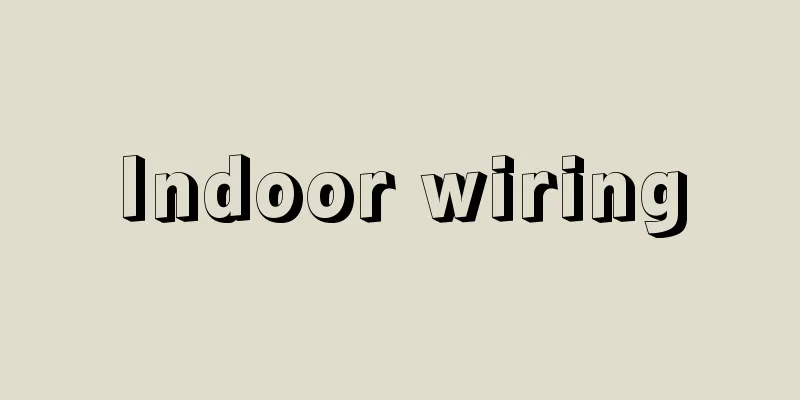Indoor wiring

|
A general term for electrical wiring installed within a building. However, it does not include internal wiring for devices such as refrigerators and room coolers, and mobile wires (cords) attached to devices. They are broadly divided into strong power line circuits (high voltage) and weak power line circuits (low voltage), depending on the nature of the electricity used, but sometimes only strong power line circuits are considered indoor wiring. Strong power refers to wiring that supplies electrical energy to devices such as electric lighting fixtures and elevators, while weak power refers to wiring for information transmission such as telephone lines and television wiring, and various measurement and control wiring. Strong and weak power are usually distinguished by the voltage used, with strong power being electrical circuits that are used for power transmission and exceed 60 volts, and weak power being circuits with low electrical energy below 60 volts and circuits that are not intended for the transmission of electrical energy. Comparing this to the human body, strong power corresponds to blood vessels, and weak power works similarly to the nervous system. However, due to the diversification of electrical devices and facilities, it is becoming difficult to clearly distinguish between strong and weak power. [Koshino Kazuji and Ichikawa Noriaki] Wiring systemThe structure of the indoor wiring system must be efficient from the power source to the load, easy to maintain and operate, and capable of transmitting electricity safely. The most common wiring system today is the method of wiring to the electrical loads in each area by branching from the power source to the main line, and then from the main line to the branch circuit. When receiving electricity from an electric power company in Japan, only one power source can be supplied to one demand location, which is called the "principle of one use area and one lead." This is to prevent the danger of the distribution system crossing within the demand location and to ensure the measurement of electricity, and the wiring system is like a tree, from the root to the trunk, and then from the trunk to the branches. In a huge load group such as a skyscraper, the trunk line is also large, and a single line alone is technically and economically problematic, so the load is divided vertically into groups of several floors each, or divided horizontally into several places, and a trunk line is installed in each block. In such a case, if a large amount of power is distributed to the load at the operating voltage (low voltage), the electric wire must be extremely thick. To transmit large amounts of power using a conductor with a small cross-sectional area, a high line voltage is required, so high voltage electricity of 3,000 to 6,000 volts is used, which is called high voltage indoor wiring (sometimes 400 volts). In high voltage indoor wiring, a distribution board is installed at the end of the main line. [Koshino Kazuji and Ichikawa Noriaki] Branch CircuitA distribution board is a connection point between a branch circuit and a trunk line, and houses branch switches that create several to a dozen branch circuits. A distribution board is a box made of metal or synthetic resin, and is made of steel plate with a thickness of 1.2 mm or more, or synthetic resin with a flame-retardant arc-resistant thickness of 1.5 mm or more. Theoretically, the number of loads connected to one branch circuit is unlimited, but in practice, in the event of an overcurrent or short circuit, a method is used to limit the current of the branch circuit to limit the area of the fault and prevent damage to the entire facility. Branch circuits with small loads are protected by circuit breakers rated at 15 to 35 amperes, and the total current of the connected loads is set to be less than the rated current of the breaker. For electric lights in ordinary homes and small appliances with a rated capacity of less than 2 kilowatts, the voltage to ground is 100 to 150 volts for single-phase two-wire or 100 to 200 volts for single-phase three-wire. Wiring for lights and small appliances in buildings other than residential buildings uses single-phase two-wire 100 volts, single-phase three-wire 100-200 volts, and three-phase three-wire 100 volts, while three-phase three-wire 200 volts is normally used for power. For the purpose of saving energy and resources, three-phase four-wire 200-400 volt wiring is sometimes used for large-capacity loads. In this case, the wiring should be installed so that people cannot easily touch it, and the voltage to ground should be 300 volts or less. Large-capacity loads such as air conditioning equipment are wired with three-phase three-wire 3000 volts or three-phase three-wire 6000 volts. [Koshino Kazuji and Ichikawa Noriaki] constructionTypes of indoor wiring work for low voltage include insulator work, synthetic resin wire trough work, synthetic resin pipe work, metal pipe work, metal wire trough work, flexible electric conduit work, metal duct work, bus duct work, floor duct work, lighting duct work, cellular duct work, and cable work. High voltage indoor wiring is limited to insulator work and cable work. Currently, metal pipe work and cable work are most commonly used. Zinc-plated steel pipes are used for metal pipes, and depending on the thickness of the pipe wall, there are thick steel pipes, thin steel pipes, and thin-walled threadless pipes. Brass pipes and copper pipes are also permitted. Metal pipes have the advantage of being excellent at protecting the electric wires housed inside the pipe from external damage, and the electric wires can be easily replaced when necessary. Cable installation is a method with a wide range of applications, and is widely used both indoors and outdoors. For indoor branch wiring, vinyl insulated vinyl sheathed flat-type VVF cable and vinyl insulated vinyl sheathed round-type VVR cable are used, the former of which is called F cable. When using F cable, the cable can be routed anywhere as long as there are no obstacles, and it is adopted in many places due to the simplicity of only supporting it with staples. Most residential construction is done using VVF installation. [Koshino Kazuji and Ichikawa Noriaki] Wires and CablesThe insulated wires used include vinyl insulated wire for entrance (DV wire; D: drop wire, V: polyvinyl chloride (PVC)), 600-volt vinyl insulated wire (IV wire; I: indoor, V: PVC), 600-volt rubber insulated wire (RB wire; R: rubber, B: braid), high-voltage insulated wire, high-voltage insulated wire for downdrafts, fluorescent light wire, insulated wire for grounding, and insulated wire for circuits. The diameter is 1.6 mm or more for high current and 1.2 mm or more for low current. The main cables are vinyl-sheathed cable, chloroprene-sheathed cable, polyethylene-sheathed cable, lead- or aluminum-sheathed cable, cab-tyre cable, and MI cable. [Koshino Kazuji and Ichikawa Noriaki] Indoor FacilitiesThe development of new materials and the application of new technologies are penetrating into the average household. Going beyond the traditional simple wiring devices such as switches, outlets, and sockets, lighting control devices, automatic doors that open and close, leakage current alarms and cutoff devices, as well as automatic indoor air conditioning adjustment devices and various crime prevention devices are now installed, and by combining these, households are becoming more complex and diverse. Furthermore, the progress of computers and their software is moving in a direction that meets the needs of an even more diverse range of consumers (users). [Koshino Kazuji and Ichikawa Noriaki] RegulationsSince indoor wiring is installed in close proximity to living spaces, safety is ensured by law. The "Electrical Equipment Technical Standards", which are based on the Electricity Business Act, stipulate standards for the design and construction of all equipment. The "Electrical Appliances and Materials Safety Act" prescribes standards for the structure and performance of the various materials that make up electrical equipment. Designated items that have been approved by the authorities are marked with the appropriate mark, and the manufacture, sale, and use of anything else is prohibited. The "Electrical Workers Act" prohibits construction by anyone other than those who hold an electrician's license, in order to maintain the technical standards of installers. [Koshino Kazuji and Ichikawa Noriaki] [Reference items] | | | |©Shogakukan "> Example of indoor wiring in an apartment building Source: Shogakukan Encyclopedia Nipponica About Encyclopedia Nipponica Information | Legend |
|
建築物内に施設される電気配線の総称。ただし、冷蔵庫、ルームクーラーなどの機器の内部配線、および機器に付属する移動電線類(コード類)は含まれない。使用される電気の性質により強電力線回路(強電)と弱電力線回路(弱電)とに大別されるが、強電力線回路だけを屋内配線とすることもある。強電とは電灯照明器具やエレベーターなどの機器に電気エネルギーを供給するための配線をいい、弱電とは電話線、テレビ配線などの情報伝達、および各種の計測、制御の配線をいう。強電と弱電との区分は、普通、使用電圧で行われ、60ボルトを超え電力伝送に使用される電気回路を強電とし、60ボルト以下の電力エネルギーの小さい回路と、電力エネルギーの伝送を目的としないものを弱電とする。これを人体に比較すれば、強電は血管に相当し、弱電は神経系統に類似した働きをするといえる。しかし、現在では電気機器や設備の多様化により、強電、弱電と明確に分離しにくいものも出現しつつある。 [越野一二・市川紀充] 配線の系統屋内配線の系統の構成は、電源から負荷まで効率よく、しかも保守や運転が容易で、安全に電気の伝達を可能にする形態が要求される。現在もっとも普遍的な配線系統方式は、電源から幹線へ、幹線から分岐回路へと順次枝分れして区域ごとの電気負荷に配線する方法である。日本国内で電力会社から電気の供給を受ける場合は、一つの需要場所へは一つの電源の供給しか受けられないことになっており、これを「一使用区域一引込みの原則」といっている。これは配電系統が需要場所内で交錯することによる危険を防止し、また電気計量を確実にするためであり、配線系統は樹木のように、1本の根元から幹へ、さらに幹から枝へという形をとっている。超高層ビルのような巨大な負荷群では、幹線も大きくなり、1条だけでは技術的にも経済的にも問題となるので、負荷を上下垂直に数階ごとのグループに分けるか、平面的に数か所に分割し、それぞれのブロックに幹線を設備している。このような場合、大電力を使用電圧(低圧)で負荷まで配電すると、電線を極端に太くしなければならない。断面積の小さな導体で大電力を伝達するには、線路電圧を高くすることを必要とするので、3000~6000ボルトの高圧電気を採用し、これを高圧屋内配線といっている(400ボルトのこともある)。高圧屋内配線では、幹線の末端に分電盤が設備される。 [越野一二・市川紀充] 分岐回路分電盤は分岐回路と幹線の接続点にあたり、数~十数の分岐回路をつくる分岐開閉器が収納される。分電盤は金属または合成樹脂製の箱で、鋼板製では厚さ1.2ミリメートル以上、合成樹脂製では難燃性の厚さ1.5ミリメートル以上の耐アーク製のものから構成される。1分岐回路に接続する負荷の数は、理論的には無制限であるが、実際的には過電流や短絡事故などの場合に、故障部分の範囲を限定し、被害が設備全体に及ぶことを防ぐため、分岐回路の電流を制限する方法がとられる。小容量負荷の分岐回路は15~35アンペアの定格の配線用遮断器により保護され、接続される負荷の総電流量は遮断器の定格電流以下となるように設定する。一般住宅などの電灯、および定格容量2キロワット未満の小型機器では、対地電圧は単相2線式100~150ボルト、または単相3線式100~200ボルトである。住宅以外のビルなどの電灯や小型機器への配線は、単相2線式100ボルト、単相3線式100~200ボルト、および三相3線式100ボルトなどを用い、動力用には普通三相3線式200ボルトが用いられる。また、省エネルギー、省資源を目的とし、大容量の負荷群には三相4線式200~400ボルト配線が採用されることもある。この場合、配線に人が容易に触れるおそれのないように施設し、対地電圧は300ボルト以下とする。冷房機器などの大容量の負荷には三相3線式3000ボルト、または三相3線式6000ボルトで配線される。 [越野一二・市川紀充] 工事屋内配線の工事の種類は、低圧では、碍子(がいし)引き工事、合成樹脂線樋(せんぴ)工事、合成樹脂管工事、金属管工事、金属線樋工事、可撓(かとう)電線管工事、金属ダクト工事、バスダクト工事、フロアダクト工事、ライティングダクト工事、セルラダクト工事、およびケーブル工事などである。また、高圧屋内配線は碍子引き工事とケーブル工事に限られている。現在もっとも多く採用されているのは金属管工事とケーブル工事である。金属管には亜鉛めっきを施した鋼管が使用され、管壁の肉厚により厚鋼管、薄鋼管、および肉厚の薄いねじなし管などがある。また、黄銅管あるいは銅管の使用も許されている。金属管の特長は、管内に収容される電線を外傷から保護する能力に優れ、必要に応じて電線を交換することが容易なことにある。ケーブル工事は適応範囲の多い工法で、屋内外を通じて広く施工されており、屋内分岐配線にはビニル絶縁ビニル被覆のVVFケーブル(vinyl insulated vinyl sheathed flat-type cable)、VVRケーブル(vinyl insulated vinyl sheathed round-type cable)が使用され、前者はFケーブルといわれている。Fケーブルでの施工では、支障のない限り任意の場所にケーブルを引き回すことができるうえに、ステップルで支持するだけの簡便性により、多くの場所で採用される。住宅工事ではほとんどがVVF工事で施工されている。 [越野一二・市川紀充] 電線・ケーブル使用される絶縁電線には、引込み用ビニル絶縁電線(DV電線。D:drop wire、V:ポリ塩化ビニルPVC)、600ボルトビニル絶縁電線(IV電線。I:indoor、V:PVC)、600ボルトゴム絶縁電線(RB電線。R:rubber、B:braid)、高圧絶縁電線、引下げ用高圧絶縁電線、蛍光灯電線、接地用絶縁電線、回路用絶縁電線などがある。太さは、強電で直径1.6ミリメートル以上、弱電で直径1.2ミリメートル以上。ケーブルは、ビニル外装ケーブル、クロロプレン外装ケーブル、ポリエチレン外装ケーブル、鉛被またはアルミ被のあるケーブル、キャブタイヤケーブルおよびMIケーブルなどがおもなものである。 [越野一二・市川紀充] 屋内設備新材料の開発、新技術の応用は一般家庭にまで浸透しつつある。従来のスイッチ、コンセント、ソケットなどの簡単な配線器具にとどまらず、照明調光装置、自動開閉ドア、漏電警報遮断装置などに加え、室内空調自動調整装置、各種防犯装置なども設備されるようになり、これらを複合することで、さらに複雑多岐になりつつある。また、コンピュータとそのソフトウェアの進歩は、さらに多様な需要家(使用者)の要求を満たす方向にある。 [越野一二・市川紀充] 法規屋内配線は生活の場に密接して設備されるので、法律により安全の確保が図られている。電気事業法を基本法とした「電気設備技術基準」では、設備全般についての設計、施工についての水準が規定されている。「電気用品安全法」では、電気設備を構成する各種材料の構造、性能の基準が定められている。指定された品目について当局の認可を受けたものには、それぞれ印が表示され、それ以外のものは製造販売ならびに使用が禁ぜられている。「電気工事士法」では、施工者の技術水準を維持するため、電気工事士の免状の取得者以外の施工が禁止されている。 [越野一二・市川紀充] [参照項目] | | | |©Shogakukan"> 集合住宅の屋内配線例 出典 小学館 日本大百科全書(ニッポニカ)日本大百科全書(ニッポニカ)について 情報 | 凡例 |
Recommend
Admission fee - Kidosen
〘 noun 〙 (from the fact that it is paid at the gat...
Tijuana - Tijuana (English spelling)
A tourist city in Baja California, in the northwe...
Anseria - Anseria
…(3) South Africa and Madagascar There are few ge...
Nakanoshima
A volcanic island located in the northern part of ...
Foot and leg soup - Foot and leg soup
…Pork is sold in chunks with the skin on, and the...
Construction - Fushin
To invite the general public to work equally. Thi...
Hygiene education - Hygiene education
...education aimed at forming the knowledge, skil...
Horsefish (Yellowtail) - Uma-uo
…It is also called wadaka, wataco (also found alo...
Fredrickson, DS
…(1) Hyperlipidemia is a condition in which one o...
Galdhøpiggen (English spelling) Galdhopiggen
…In Norse mythology, it is the mountain inhabited...
Tajik - Tajikgo (English spelling)
Along with Persian, it is one of the western diale...
Transportation industry - Unsougyo
A business that transports passengers and cargo in...
Brass instrument - Kinkan-gakki (English spelling) brass instrument English
A general term for wind instruments that produce ...
Kybele (English spelling)
A goddess who had been widely worshipped in Asia M...
Pindemonte, Ippolito
Born: November 13, 1753, Verona [Died] November 18...









